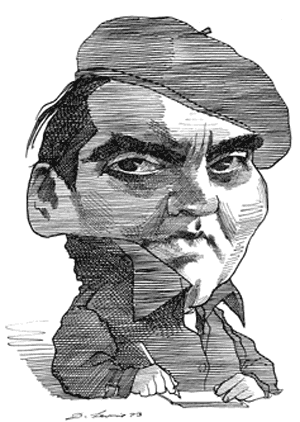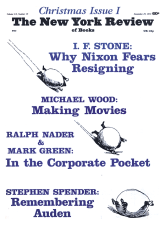Thirty-seven years after the killing of the poet Federico Garcia Lorca, whose fame had already spread far beyond Spain at the time of his death, it is still impossible to be absolutely certain of the accomplices in the crime and the exact motives for it. Even now, when Lorca’s name is rehabilitated in Spain—owing to foreign opinion—and the act has been officially deplored because of the damage it did (and still does) to the image of Franco’s “National Cause,” the blame is shifted from one group to another, without naming names. People who might have told much have died; some who could tell have grown old, memories have become vague or evasive. In Granada people waver between caution and fantasy. As in southern Ireland after the civil war of the Twenties, among those once close to the crimes committed there are embarrassment, the wish to forget, generalized talk of personal jealousies and “uncontrollable elements” that “come to the surface” in such times.
In Granada where Lorca died there was for example a “Black Squad” of lawless killers who were given carte blanche by Valdés, the civil governor, to terrorize the city. They mainly butchered workers in the streets or dragged the wounded from the hospitals. The names of many of these monsters are well known; many died violently, one committed suicide, one still thrives as a timber merchant, another became, of all things, a university professor. When the Franco apologists speak nowadays of “uncontrollable elements” they half hope we shall think Lorca fell to them. In fact it has been established that the arrest and shooting were very much a hysterical official affair and the work of “respectable” people in the quarrelling groups who were important in Granada. The moderate CEDA blames the Falange, the Falange blames the CEDA or the Acción Popular, and the story becomes a triangle of factions and provincial personalities. In any case the Andalusians are spontaneous inventors of hearsay and love to dramatize it. They play up, as the Irish play up to Joyce scholars.
Ian Gibson is the latest foreign investigator to go into the mystery. The pioneer, of course, was Gerald Brenan (the Spanish scholar who has lived in Andalusia most of his life) in his Face of Spain, published in the Fifties. Since then the French writer Claude Couffon, like Brenan, thought the murder might have been a reprisal for the death of Benavente. However, this suggestion came from a hysterical speech by the bloodthirsty Quiepo de Llano, who was trying to excuse his blunder in giving the order: Benavente lived long after the civil war. Quiepo de Llano may very well have believed the rumor and it seems probable—and is indeed reported—that he told the hesitant governor of Granada “to give Lorca coffee, lots of coffee”—Quiepo’s favorite euphemism when ordering an execution. Enzo Cobelli, an Italian, came to the conclusion that Lorca was a pawn in the struggle between the Falange and the Army represented by a Captain Nestares, who was in charge of the executions at Viznar. (Nestares is still alive, very rich, but Mr. Gibson could get nothing out of him.)
A third work by Marcelle Auclair seems to Mr. Gibson to come closer to probability. It is well established that an informer or agent called Ruiz Alonso played a part in the arrest of Lorca, who was hiding in the house of a close Falangist friend, Rosales. The Rosales family were political enemies of Ruiz Alonso, who was a religious fanatic, and he decided to get them into trouble for hiding the poet. A fourth work by Jean-Louis Schonberg argued that there was nothing political in the arrest and that it was a vengeance springing out of homosexual jealousy. (Lorca was indeed homosexual, though he regarded himself as one of the “pure” as distinct from the “impure” homosexuals.) In Schonberg’s argument Ruiz Alonso was also homosexual and was jealous of the poet. This was exploited by a Granadino painter, in order to save his own skin. (When Gibson put this to Ruiz Alonso he made a dramatic rhetorical scene, proclaimed his heterosexual virility was famous, and offered to seduce the women folk of the critics who denied it.) I agree that Schonberg sounds like an erotic sensationalist taking advantage of the myth of Spanish machismo.
Mr. Gibson’s patient examination of the known evidence and his own further, persistent inquiries, which include interviews that were very bold, have led him to believe that the persecution of Lorca was initiated:
…not by any one man but by a group of ultra-Catholic members and like-minded members of Acción Popular, among whom Ruiz Alonso, as an ex-deputy of the CEDA, was most influential….
The men who took Lorca off from the Rosales house with Ruiz Alonso included a rich landowner called Trecastro and one other. All were members of that fanatical religious group. All, except Alonso, are dead. Trecastro, a roystering Andalusian womanizer and therefore a hero of the Granada cafés, boasted of his part in the arrest and, seemingly, the execution. These things do not constitute proof but there is no doubt that the Acción Popular hated Lorca for his family contacts with the liberal intellectuals of Granada who had brought a celebrity to the city which is now lost and sold to package tourism.
Advertisement
The labyrinth to which this book introduces us is incomprehensible without knowledge of Spanish history, the conflict of the intellectuals with the Church in the nineteenth and twentieth centuries, and the politics of the Second Republic after 1931. Fortunately Mr. Gibson is succinct about these matters and is particularly good on the situation in Granada. The picturesque and moribund city had become attractive to distinguished foreigners and Spaniards, and a center for artists and intellectuals drawn first by the beauty of the Alhambra, which was being intelligently restored, and by Andalusian music. By the end of the century the university had an enormously influential figure in the person of the socialist Fernando de los Rios, whose family were closely connected with the brilliant anti-clerical educationalists and writers known as “the generation of ’98.” They have had no successors.
At the same time, the city had become rich by the introduction of the sugar beet into the fertile vega outside it; a new, wealthy bourgeoisie grew up and their Granada, already deep in the fame of being a symbol of the defeat of the Moors, the persecution of the Jews, and the unification of the country, was now about the most obdurately conservative city of the south and beginning to feel the world-wide economic depression. Conditions of life for the peasants were bad; they had begun to organize themselves politically; the middle classes were undoubtedly terrified. It is interesting that Ruiz Alonso—not a native of the province—came from a family that had gone downhill; he had become a printer. His resentment was the classic fascist one of the lower-middle-class “chip.” The established rich in Spain have always held to the traditionalist Catholicism and the militant and violently intolerant spirit of the Counter Reformation. From the early nineteenth century onward they have been totally opposed to liberal reform, especially in education.
By the Twenties—when I first went to Granada and spent some time with Fernando de los Rios—I was, like most foreigners astonished by the absolute division between the Catholic and the liberal groups. There was not merely hostility of opinion, there were personal hatred, social ostracism, and undeclared civil war. The hatred was for the intellect, especially for an intellect which had contacts outside Spain. The Acción Popular would hate Lorca simply because he was a playwright and poet, famous everywhere and connected with the intelligentsia in Granada, Madrid, Paris, and New York. Politically he was naïve; he was simply and generously on the side of the poor, for his art derived from the popular culture of the vega. But he had no party connections; for him “the people” did not mean “the People” of left-wing politicians. He was closely related to the de los Rios family, but he was equally a friend of the Falangist Rosales and of the young José Antonio Primo de Rivera, leader of the Falange.
To Lorca as to hundreds of gifted and independent people like him, the anarchic state of Spain was a torment that frightened him. It was in deep depression and fear that he went home to his family in Granada when the rising was about to break. It seems that Ruiz Alonso was on the night train that took Lorca to Granada. When, weeks later, Alonso came to the house of Rosales where Lorca was hiding and Rosales asked what charges were made against the poet, Alonso’s reply was, “He did more damage by his pen than others did with their guns.” In that there is all the rancor of the slave turned informer.
One of Mr. Gibson’s achievements is to have secretly taped Alonso’s rambling rhetorical attempts in old age to blow up his importance and disown his responsibility. There are streams of religious justification and self-praise. If in the end Mr. Gibson’s indefatigable inquiries bring no certainty, they have led him through the ghastly scenes of the Franco terror in Granada. Over 4,000 people were shot in the city alone. The trucks loaded up the prisoners, among them a large number of famous lawyers, doctors, surgeons, university professors, and carried them out night after night to be shot against a country wall.
Readers of this book may think of it as an exercise in detection, and a very able one, and may be tempted to say, with the Franco sympathizers, that the same went on on both sides. It did. But as Mr. Gibson says:
Advertisement
Had Federico not died that morning at Viznar, the thousands of other innocent, but less well known granadinos liquidated by the rebels might have been forgotten. As it is they will be remembered long after those responsible for the repression have passed into oblivion.
Seen in this light of course Lorca’s death has a symbolic significance that goes far beyond Granada to the thousands who fell to the ferocity which Franco awakened in a nation notoriously prone to it.
This Issue
November 29, 1973




